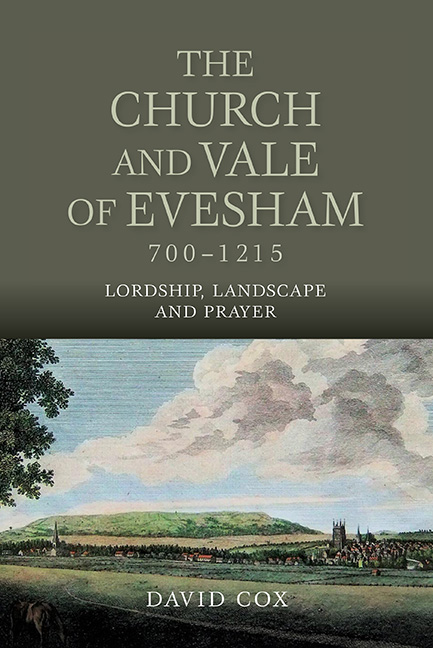Book contents
- Frontmatter
- Dedication
- Contents
- List of Illustrations
- Preface
- Timeline
- List of Abbreviations
- Part I From Minster to Abbey (701–1078)
- Part II Abbot Walter (1078–1104)
- Part III Twelfth-Century Themes (1104–1215)
- Afterword
- Appendix: The Abbots of Evesham to 1215
- Select Bibliography
- Index
- Miscellaneous Endmatter
- Frontmatter
- Dedication
- Contents
- List of Illustrations
- Preface
- Timeline
- List of Abbreviations
- Part I From Minster to Abbey (701–1078)
- Part II Abbot Walter (1078–1104)
- Part III Twelfth-Century Themes (1104–1215)
- Afterword
- Appendix: The Abbots of Evesham to 1215
- Select Bibliography
- Index
- Miscellaneous Endmatter
Summary
IT is clear from archaeological finds that Anglo-Saxon cultural influences had arrived in the left-bank area by the early sixth century, and by the end of the seventh century there were several burial grounds in which the graves were furnished in Germanic style with such items as beads, brooches, spears, and shields. Before the Norman Conquest other places nearby were reputed to be the sites of pagan burials. The richest of the Germanic-style graves known to us were discovered when a railway cutting was made at Great Hampton near Evesham in 1862. The remains of at least two people were found there and two spearheads and a large knife blade were recovered. Also in the graves at Great Hampton was a delicately made seventh-century gold and garnet pin suite, a dress or hair fastening made up of two pins linked by an ornamental chain and pendant. So costly an item shows that in the seventh century the local population included not only subsistence farmers but also men and women with money and prestige. Such privileged people may have had high standing within an orderly and stratified society; order is certainly implied by the existence of an early place of public assembly at a burial mound called ‘Fissesberg’ (‘Fisc's barrow’), which has been plausibly identified at Blackminster near Offenham (Fig. 3). From some unknown period matters affecting the whole area were discussed there and decisions approved and promulgated. Much remains uncertain but it seems reasonable to believe that Evesham minster's lands on the left bank of the Avon were not marginal in 703 but were populous and productive, just as they had been in Roman times. There is even some evidence that in 703 the farmers, though Anglo-Saxon in culture, were of the same Celtic blood as their Romano-British predecessors and were occupying settlements that had evolved directly from theirs.
The Britons
Anglo-Saxon culture pervaded the Vale of Evesham by the end of the seventh century but most of the inhabitants of the minster's land on both sides of the river were probably descended from Iron Age or Romano-British people. Local evidence of that comes from the former land unit known as ‘Wycweon’, which lay about two miles south-east of Evesham and has long been divided into the conjoined parishes of Childswickham and Wickhamford (Fig. 3).
- Type
- Chapter
- Information
- The Church and Vale of Evesham, 700-1215Lordship, Landscape and Prayer, pp. 24 - 32Publisher: Boydell & BrewerPrint publication year: 2015

